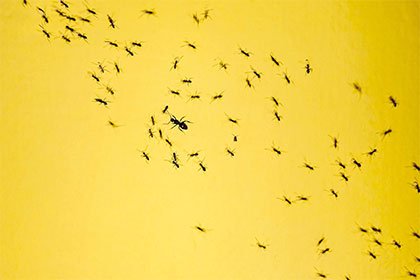In Quebec, 5 species of ants are listed.
- black ant spoils;
- pharaoh ant;
- red carpenter ;
- ant of the pavements;
- brown ant (from Argentina);
In this article, we will cover the main characteristics of three types in particular. The carpenter ant, a species whose queen is a winged ant. The Pharaoh ant, a very small ant of about 2 mm. Andthe pavement ant, commonly called the sand ant.
Carpenter Ants
The most common species of carpenter ants is the black carpenter ant, whose scientific name is: Camponotus pennsylvanicus.
It nests mainly in deciduous trees, decaying logs and wooden structures. Nests are located in urban and suburban areas, such as in grassy areas between buildings or in parks. Nests are also found in dense forests, agricultural fields, open areas such as meadows/fields and along rivers.
The size of a carpenter ant varies between 6.35 mm and 12.7 mm.
In our homes
In houses, the carpenter ant looks for the damp frame to make its tunnels. Where there is water infiltration, there is a potential carpenter ant problem.
The reproductive ant in a colony, i.e. the queen, is winged. They have wings.
Pharaoh Ants
Also known as the sugar ant, the pharaoh ant, from its Latin name: Monomorium pharaonis, has a very small body of about 2 mm.
Worker ants have a body coloration that varies from golden yellow to a reddish brown.
They have a lifespan of about 70 days.
The breeding males are the same size as the workers. However, they are black in color and are rarely found in the nest.
The queens are 4 mm long and slightly darker than the workers. Queens can live for a year and lay up to 35 eggs a day.
The pharaoh ant, like other invasive ant species, is able to expand rapidly into new territories and multiply in numbers rapidly.
This leads to the displacement of other ant species that are already in the territory. For example, a colony of carpenter ants, whose territory is conquered, is forced to leave its habitat and find a new one.
As a result, the pharaoh ant causes the local extinction of other ant species.
Pavement ants (or sand ants)
Pavement ants are uniform in size. It measures approximately 4.8 mm. They are brown and black with paler legs and antennae. Distinctive parallel ridges or grooves are visible on the head and thorax.
Sand ants form feeding trails. Colonies can contain up to 10,000 ants. In urban areas, they often nest in cracks in sidewalks and pavements. Their nests can be found near trees.
Their nests are small craters of sand. These are visible nests. They are rarely hidden. Although they can sting, these ants are not aggressive. They are omnivorous and will be attracted by meat, fat and honey. They can become a problem after heavy rains when their nests are displaced and surface.
Contact Brisebois Extermination
At Brisebois extermination, we are a team of professional and efficient exterminators.
Each technician has a permit from the Ministère du Développement Durable du Québec and acts in accordance with Environment Canada regulations.
For any ant problem, our specialists will offer you an effective solution. Just call us!

